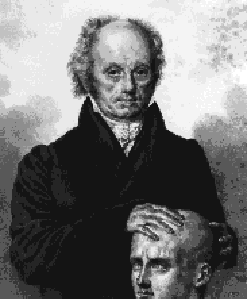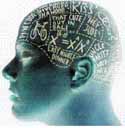from 1911 Edition Encyclopedia...
the founder of phrenology
Franz Joseph Gall
( 1758-1828 )
FRANZ JOSEPH GALL
GALL, FRANZ JOSEPH (1758 -1828), anatomist, physiologist, and founder of phrenology, was born at Tiefenbrunn near Pforzheim, Baden, on the 9th of March 1758. After completing the usual literary course at Baden and Bruchsal, he began the study of medicine under J. Hermann (1738-1800) at Strassburg, whence, attracted by the names of Gerhard van Swieten (1700-1772) and Maximilian Stoll (1742-1788), he removed to Vienna in 1781. Having received his diploma, he began to practise as a physician there in 1785; but his energies were mainly devoted to the scientific investigation of problems which had occupied his attention from boyhood. At a comparatively early period he formed the generalization that in the human subject at least a powerful memory is invariably associated with prominent eyes; and further observation enabled him, as he thought, also to define the external characteristics indicative of special talents for painting, music and the mechanical arts. Following out these researches, be gradually reached the strong conviction, not only that the talents and dispositions of men are dependent upon the functions of the brain, but also that they maybe inferred with perfect exactitude and precision from the external appearances of the skull. Gall’s first appearance as an author was made in 1791, when he published the first two chapters of a (never completed) work entitled Philosophisch-medicinische Unlersucliungen -uber Natur u. Kunsi im kranken u. gesunden Zustande des Menschen. The first public notice of his inquiries in cranioscopy, however, was in the form of a letter addressed to a friend, which appeared in C. M. Wieland’s Deutscher Mercur in 1798; but two years previously he had begun to give private courses of phrenological lectures in Vienna, where his doctrines soon attracted general attention, and met with increasing success until, in 1802, they were interdicted by the government as being dangerous to religion. This step on the part of the authorities had the effect of greatly stimulating public curiosity and increasing Gall’s celebrity.In March 1805 he finally left Vienna in company with his friend and associate J. C. Spurzheim, and made a tour through Germany, in the course of which he lectured in Berlin, Dresden, Magdeburg and several of the university towns. His expositions, which he knew how to make popular and attractive, were much resorted to by the public, and excited considerable controversy in the scientific world. He had almost reached the zenith of his fame when, in 1807, he repaired to Paris and established himself there as a medical practitioner, at the same time continuing his activity as a lecturer and writer. In 1808 appeared his Introduc‘ion au cours de physiologie du cerveau, which was followed in 1809 by the Recherches si~r le système nerveux en général, et sur celui du cerveau en particulier (originally laid before the Institute of France in March 1808), and in 1810 by the first instalment of the Anatomie et physiologie du système nerveux en general, et du cerveau en paiticulier, avec des observations sur la possibilite de reconnautre plusieurs dispositions intellectuelles et morales de l’/wmme el des animaux par la configuration de leurs têtes. The Rec/zerches and the first two volumes of the Anatomie bear the conjoint names of Gall and Spurzheim. The latter work was completed in 1819, and appeared in a second edition of six volumes in 1822-1825. In 1811 he replied to a charge of Spinozism or atheism, which had been strongly urged against him, by a treatise entitled Des dispositions innées de l’dme et de l’esprit, which he afterwards incorporated with his greater work. In 1819 he became a naturalized French subject, but his efforts two years afterwards to obtain admission to the Academy of Sciences, although supported by E. Geoffroy Saint-Hilaire, were unsuccessful. In 1823 he visited London with the intention of giving a series of phrenological lectures, but his reception was not what he had anticipated, and he speedily abandoned his plans. He continued to lecture and practise in Paris until the beginning of 1828, when he was disabled by an apoplectic seizure. His death took place at Montrouge near Paris, on the 22nd of August 1828.
* * *Gall suggested that the brain was divided into 27 separate "organs,". Each organ suppposedly corresponded to a discrete human faculty, though Gall identified 19 of these faculties as being shared with other animal species.
The first nineteen in the list below are organs allegedly common to men and animals; the final eight are specific to humans:
- The instinct of reproduction (located in the cerebellum)
- The love of one's offspring
- Affection; friendship
- The instinct of self-defence; courage; the tendency to get into fights. 5. The carnivorous instinct; the tendency to murder
- Guile; acuteness; cleverness
- The feeling of property; the instinct of stocking up on food (in animals); covetousness; the tendency to steal
- Pride; arrogance; haughtiness; love of authority; loftiness
- Vanity; ambition; love of glory (a quality "beneficent for the individual and for society")
- Circumspection; forethought
- The memory of things; the memory of facts; educability; perfectibility
- The sense of places; of space proportions
- The memory of people; the sense of people
- The memory of words
- The sense of language; of speech
- The sense of colours
- The sense of sounds; the gift of music
- The sense of connectness between numbers
- The sense of mechanics, of construction; the talent for architecture. 20. Comparative sagacity
- The sense of metaphysics
- The sense of satire; the sense of witticism
- The poetical talent
- Kindness; benevolence; gentleness; compassion; sensitivity; moral sense
- The faculty to imitate; the mimic
- The organ of religion
- The firmness of purpose; constancy; perseverance; obstinacy.
HOME
Ratbots
Karl Lashley
Orgasmatrons
Phrenological Map
The Criminal Mind?
The Pleasure Centres?
Somatosensory homunculus
American Phrenology Journal

